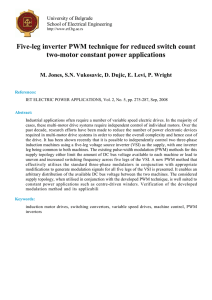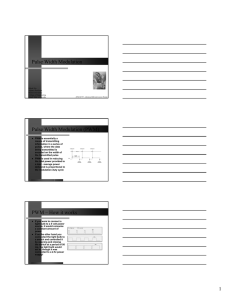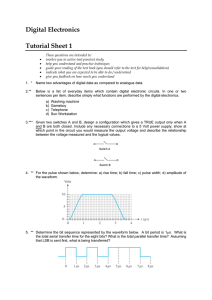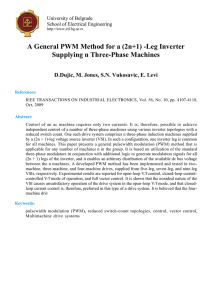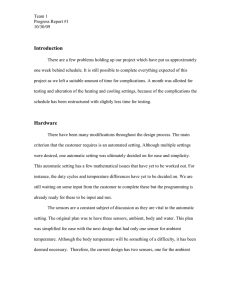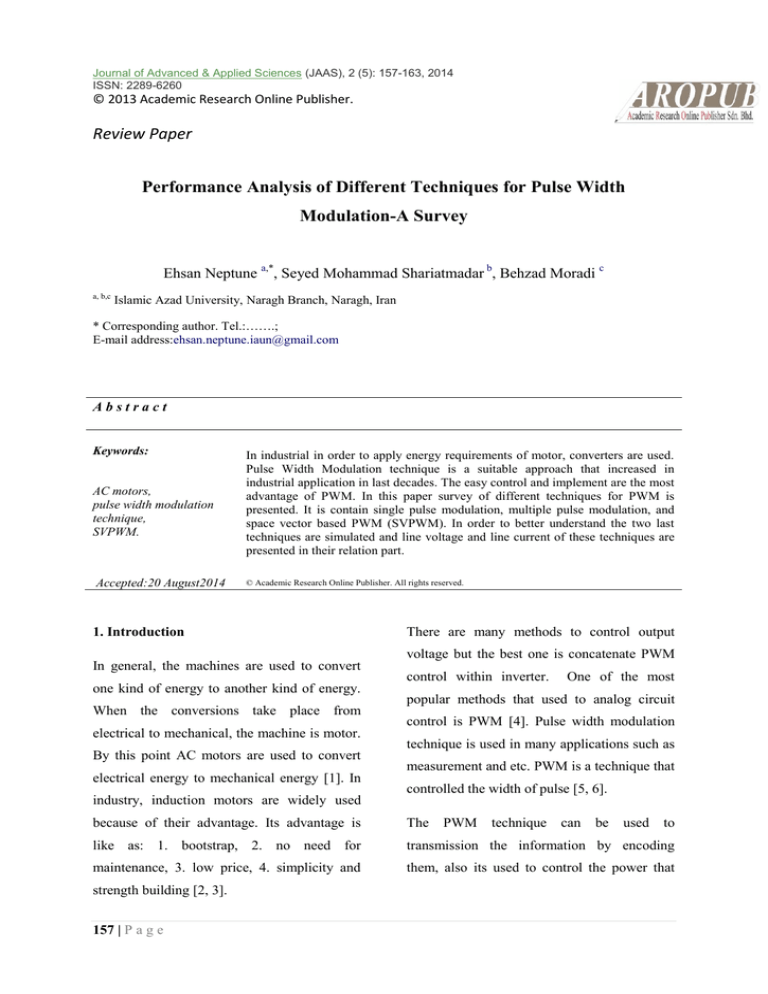
Journal of Advanced & Applied Sciences (JAAS), 2 (5): 157-163, 2014
ISSN: 2289-6260
© 2013 Academic Research Online Publisher.
Review Paper
Performance Analysis of Different Techniques for Pulse Width
Modulation-A Survey
Ehsan Neptune a,*, Seyed Mohammad Shariatmadar b, Behzad Moradi c
a, b,c
Islamic Azad University, Naragh Branch, Naragh, Iran
* Corresponding author. Tel.:…….;
E-mail address:ehsan.neptune.iaun@gmail.com
Abstract
Keywords:
AC motors,
pulse width modulation
technique,
SVPWM.
Accepted:20 August2014
In industrial in order to apply energy requirements of motor, converters are used.
Pulse Width Modulation technique is a suitable approach that increased in
industrial application in last decades. The easy control and implement are the most
advantage of PWM. In this paper survey of different techniques for PWM is
presented. It is contain single pulse modulation, multiple pulse modulation, and
space vector based PWM (SVPWM). In order to better understand the two last
techniques are simulated and line voltage and line current of these techniques are
presented in their relation part.
© Academic Research Online Publisher. All rights reserved.
1. Introduction
There are many methods to control output
voltage but the best one is concatenate PWM
In general, the machines are used to convert
one kind of energy to another kind of energy.
When the conversions take place from
electrical to mechanical, the machine is motor.
By this point AC motors are used to convert
electrical energy to mechanical energy [1]. In
control within inverter.
One of the most
popular methods that used to analog circuit
control is PWM [4]. Pulse width modulation
technique is used in many applications such as
measurement and etc. PWM is a technique that
controlled the width of pulse [5, 6].
industry, induction motors are widely used
because of their advantage. Its advantage is
The
like as: 1. bootstrap, 2. no need for
transmission the information by encoding
maintenance, 3. low price, 4. simplicity and
them, also its used to control the power that
strength building [2, 3].
157 | P a g e
PWM
technique
can
be
used
to
Ehsan Neptune et al. / Journal of Advanced & Applied Sciences (JAAS), 2 (5): 157-163, 2014
applied to the electrical device, in other word
advantage of this method. We have power loss
it’s its main use.
when there is voltage or current, so in this
technique because of the Absence of voltage
In last two decades many kinds of PWM
technique
have
been
studied
[7].
or current, power loss is zero.
The
descriptions of PWM is contains the different
kind of methods, concept and performance.
There are many parameters that have effect on
2. PWM techniques
their implementation ac drives, such as power
In this part different kind of PWM technique is
level and semiconductor device [8]. The
presented. These different kinds are containing
amount of average value of voltage or current
single
that applied to the load can be control by
modulations, and Space Vector based PWM
turning on and off the switch. This switch
(SVPWM).
pulse
modulation,
multiple
pulse
works at the fast speed. In general, the
switching will be done several times in a
2.1. Single pulse width modulation
minute and it’s different for each device. In a
In this technique, in every half-cycle there is
faint lamp it’s 120 Hz and for motor drive it’s
just one pulse and width is depends on
different from few kHz to tens of kHz.
requirements of output voltage. As it’s clear
Proportion of ‘on’ time to the interval time is
from figure 1, by this technique the reference
defined as duty cycle. The duty cycle has
signal is converted to square wave signal. To
direct proportion with power [9, 10].
obtain this square wave, the positive output
Since the power loss in PWM technique is
very low, it can be mentioned that is the best
signal is related to the positive input and
negative output is related to negative input [11,
12].
Fig. 1: Gating signal production of single PWM
158 | P a g e
Ehsan Neptune et al. / Journal of Advanced & Applied Sciences (JAAS), 2 (5): 157-163, 2014
The
switching
waveform
frequency
of
triangle
is . By this frequency the
speed of inverter switching (turning on and
off) is controlled. To modulate the switch duty
ratio, The control signal,
frequency of
, by the
is used. This is the
fundamental frequency of the inverter voltage
output. Since the output of the inverter is
affected by the switching frequency it will
contain harmonics at the switching frequency
[13]. The duty cycle of the one of the inverter
switches is called the amplitude modulation
ratio,
2.2. Multiple pulse width modulations
In this technique the amount of harmonic is
reduced by applying multiple pulses in each
output voltage half cycle. Figure 2 shows the
signal for turning on and turning off
transistors. This signal is produced by
comparing reference signal (with
frequency) with triangular carrier wave (with
as output frequency). Modulation index is
varied from 0 to 1. By this variation, pulse be
varied from 0 to ⁄ and follow of that, the
output voltage variation is from 0 to
.
(1)
[14].
Where:
(2)
Fig. 2: Gating signal production of multiple PWM
159 | P a g e
as output
(3)
Ehsan Neptune et al. / Journal of Advanced & Applied Sciences (JAAS), 2 (5): 157-163, 2014
Line voltage and line current of multiple pulse
and 4 respectively.
width modulations are presented in figures 3
LINE VOLTAGE
800
600
LINE VOLTAGE(VOLT)
400
200
0
-200
-400
-600
-800
0
0.05
0.1
0.15
0.2
TIME(SECOND)
0.25
0.3
0.35
0.4
0.35
0.4
Fig. 3: Line voltage of multiple pulse width modulations
LINE CURRENT
80
60
LINE CURRENT(AMP)
40
20
0
-20
-40
-60
0
0.05
0.1
0.15
0.2
TIME(SECOND)
0.25
0.3
Fig 4: Line current of multiple pulse width modulations
2.3. Space vector pulse width modulations
In power conversion space vector pulse width
modulation has essential and viable role. The
3. The THD is minimum in switching
wave form
4. Its implementation is easy and its
computational calculations is very low
main goals of gate pulse generating SVPWM
are as follow [15]:
SVPWM is used to control the output voltage
and input current. SVPWM technique is an
1. Wide linear range of modulation
2. Switching loss is minimum
advantage since it increased the flexibility of
switching.
Under
unbalanced
conditions
SVPWM can have useful advantage [16, 17].
160 | P a g e
Ehsan Neptune et al. / Journal of Advanced & Applied Sciences (JAAS), 2 (5): 157-163, 2014
Fig. 5: Circuit of three phase-voltage source inverter.
To implement of SVPWM, voltage equation
(4)
can be transformed from abs frames to d-q
reference frame. Equation 4and 5 shows its
Where:
relation. dq and ABC reference frame is
showed in figure 6.
[ ⁄
⁄
⁄
√ ⁄
√ ⁄
⁄
⁄
(5)
]
And f can be voltage or current.
Figure 7 shows the responds of line voltage for
space vector pulse width modulations and the
line current is presented in figure 8.
Fig. 6: dq and ABC Reference Frame
161 | P a g e
Ehsan Neptune et al. / Journal of Advanced & Applied Sciences (JAAS), 2 (5): 157-163, 2014
LINE VOLTAGE
800
600
LINE VOLTAGE(VOLT)
400
200
0
-200
-400
-600
-800
0
0.05
0.1
0.15
0.2
TIME(SECOND)
0.25
0.3
0.35
0.4
Fig. 7: .line voltage of space vector pulse width modulations
LINE CURRENT
60
40
LINE CURRENT(AMP)
20
0
-20
-40
-60
-80
0
0.05
0.1
0.15
0.2
TIME(SECOND)
0.25
0.3
0.35
0.4
Fig. 8: .line current of space vector pulse width modulations
the quality is better, total harmonic distortion
3. Conclusion
(THD) is lesser and torque ripple is reduced.
There are many methods to control output
voltage but the best one is concatenate PWM
control within inverter.
By proportion
switching and applying fixed dc voltage to
inverter, ac output voltage will be produced.
Pulse Width Modulation technique is a
suitable approach that increased in industrial
application in last decades. The easy control
and implement are the most advantage of
PWM. In all of the methods that are used to
controlling AC motors, SVPWM is the best
one.
Comparison
of
SVPWM
and
conventional methods shows that in SVPWM
162 | P a g e
References
[1] Edward J. Thornto, J. kirk Armintor. The
fundumentals of ac electric induction motor
desige and application. proceeding of the
twentieth
international
pump
users
symposium, 2003.
[2]
Miralem
HADŽISELIMOVIĆ,
ZAGRADIŠNIK,
Bojan
Ivan
ŠTUMBERGER.
Induction Machine: Comparison of Motor and
Generator
Characteristics.
elektrotechniczny, 2013.
przegląd
Ehsan Neptune et al. / Journal of Advanced & Applied Sciences (JAAS), 2 (5): 157-163, 2014
[3] Maciej Wieczorek, Eugeniusz Rosołowsk,
Inverter. First International Power And Energy
.Modelling of Induction Motor for Simulation
Coference Pecon, 2006; 28-29.
of Internal Faults. Modern Electric Power
[12] Owen, E.L. History [origin of the
Systems, Wroclaw, Poland 2010.
inverter]. Industry Applications Magazine,
[4] J. Holtz, W. Lotzkat, and A. M.
IEEE, 1966; 2(1) :64-66.
Khambadadkone, On continous control of
[13] Nazmul Islam Raju, Md. Shahinur Islam,
PWM inverters in the overmodulation range
Ahmed Ahsan Uddin. Sinusoidal PWM Signal
including the six-step mode IEEE Trans.
Generation
Power Electron, 1993; 8:546–553.
Voltage Source Inverter with Analog Circuit &
[5] L. Malesani and P. Tomasin. PWM current
Simulation of PWM Inverter for Standalone
control
Load
techniques
of
voltage
source
Technique
&
for
Three
Micro-grid
Phase
System.
converters—A survey. in Conf. Rec. IEEE
INTERNATIONAL
IECON, Maui, HI, 1993; 670–675.
RENEWABLE ENERGY RESEARCH, 3(3).
[6] S. Ogasawara, H. Akagi, and A. Nabae. A
[14]
novel PWM scheme of voltage inverter based
Techniques
(MPWM),
on space vector theory. in Proc. EPE Conf.,
Technology
Laser
1989; 1197–1202.
Engineering Department Laser Engineering
[7] ADAMS, R.D. and FOX, R.S. Several
Branch Power Electronics Laboratory 2011-
modulation techniques of PWM inverter.
2012.
IEEE Conference record of fifth annual
[15] Wajiha Shireen, Srinivas Vanapalli,
meeting of industry and general applications
Hrishikesh Nene. A DSP Based SVPWM
group, 1970; 687-695
Control for Utility Interactive Inverters used in
[8] POLLACK, J.J. Advanced pulse width
Alternate Energy Systems. IEEE Transactions
modulated inverter techniques, 1972; 145-154.
on Industrial Electronics, 2006.
[9]
modulation
[16] Y-H Lee, D-H Kim, D-S Hyun. Carrier
technique in static PWM inverters. IEEETrans.
Based SVPWM Method for Multi-Level
Ind. Appl., 1981; 1(2):199-204.
system with reduced HDF. In the thirty-fifth
[10] W.Mc Murray. Modulation of the
IEEE Annual Meeting and World Conferences
chopping
on Industrial Applications of Electrical Energy
P.D.Ziogas.
The
frequency
delta
indc
choppers
and
Multi
Pulse
JOURNAL
Width
Modulation
University
and
of
of
Optoelectronics
inverters having current hysteresis controllers.
CD-Rom proceedings.
IEEE Trans. Ind. Appl, 1984: 20(4): 763-768.
[17]
[11] B. Ismail, s.taib mieee, a. R mohd saad,
Y.R.Tagore.
m. Isa, C. M. Hadzer. Development Of A
Modulation Schemes for Two-Level Voltage
Single Phase Spwm Microcontroller-Based
Source Inverter. ACEEE Int. J. on Control
P.Tripura,
Space
Y.S.Kishore
Babu,
Vector
Width
Pulse
System and Instrumentation, 2011; 2(3).
163 | P a g e

